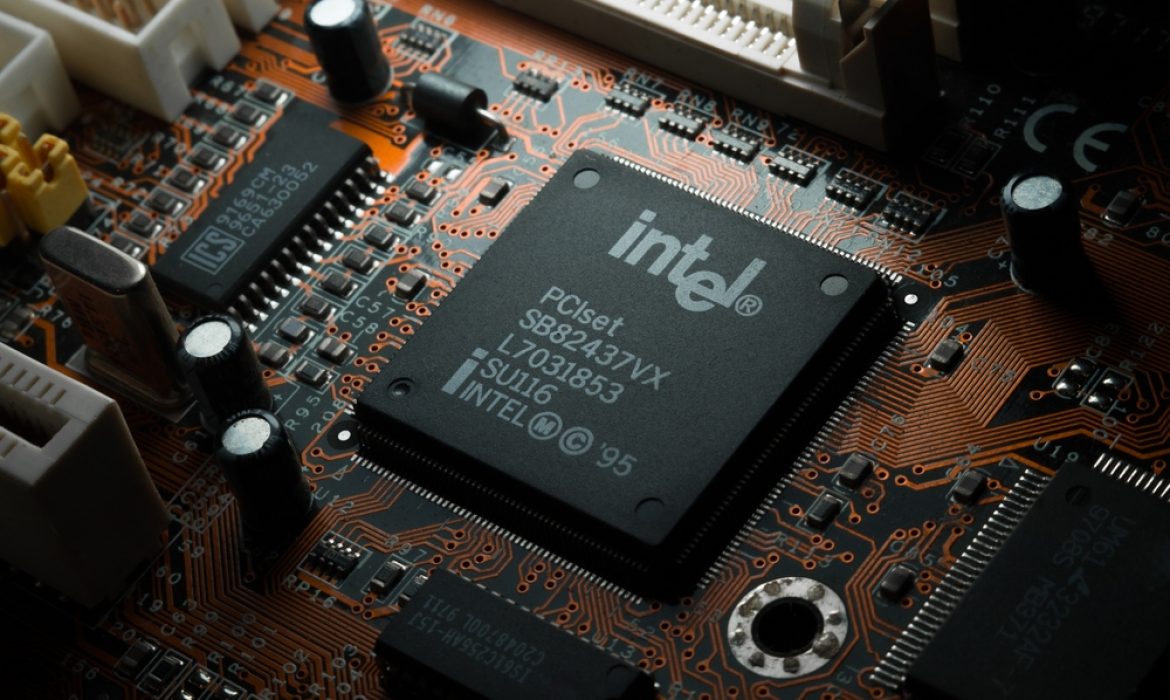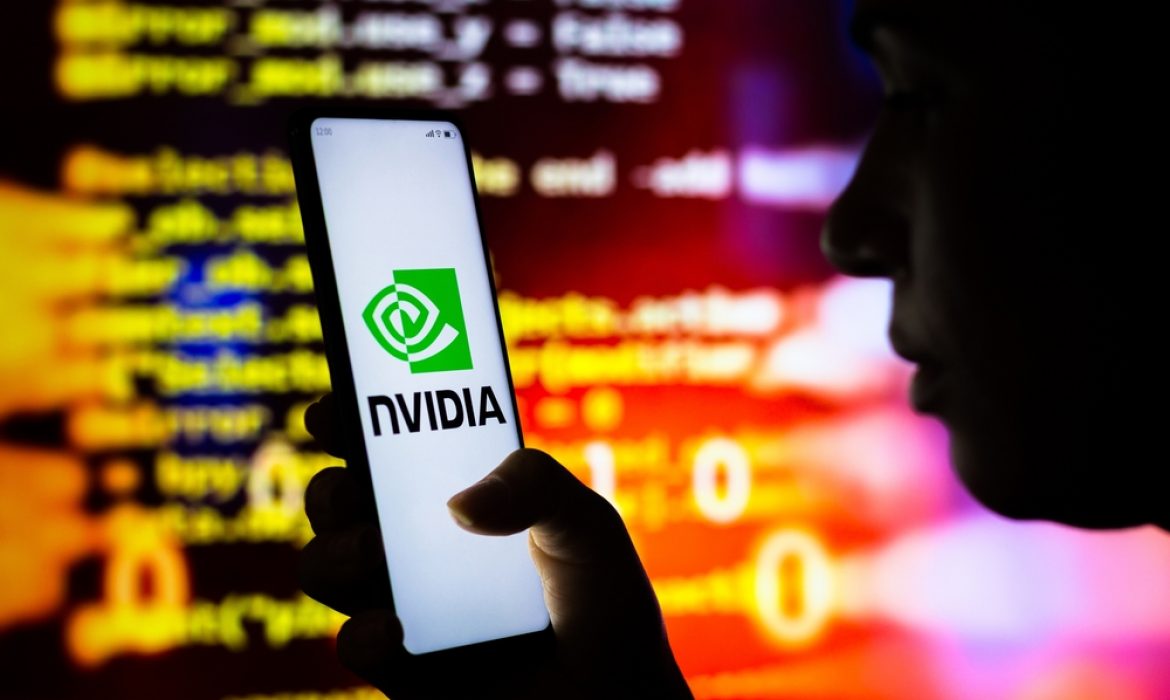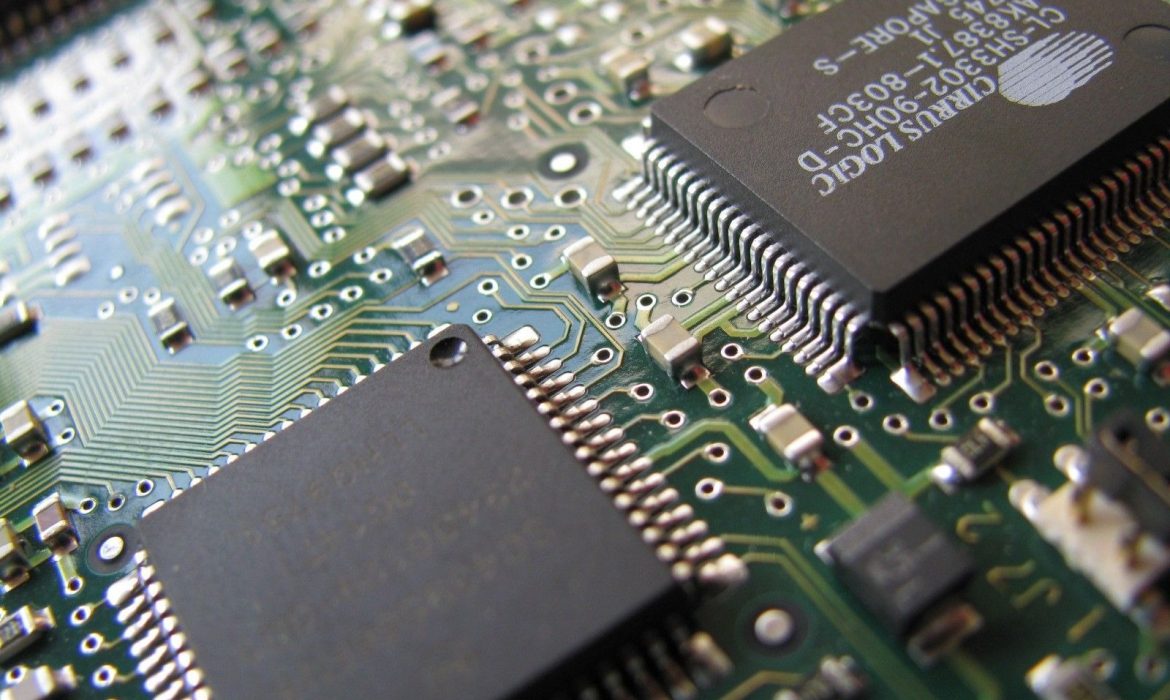Intel’s PowerVia: A Revolution in Chipmaking
Intel, a titan in the world of semiconductor technology, is poised to disrupt chip manufacturing as we know it with its revolutionary PowerVia. This groundbreaking innovation is set to transform the very foundations of how chips are made and tested, opening new horizons in performance and efficiency.
Traditionally, computer chips have been constructed layer by layer, from the bottom up, resembling the assembly of a pizza. Transistors, the tiniest features, form the initial layer. Subsequently, more layers are added, with increasingly less-tiny wires connecting these transistors and various chip components (known as interconnects). These top layers also carry the vital power supply for the chip’s operation.
However, as chips become smaller and denser, the layers, interconnects, and power connections have turned into a complex web, hampering overall chip performance. Power and signal integrity have now become crucial issues, requiring workarounds or excessive power injection.
Intel foresaw these challenges and embarked on a visionary path towards a solution dubbed “backside power.” This groundbreaking approach relocates the power wires from the front to the backside of the chip, leaving the front side exclusively for interconnections.
Intel’s backside power solution, known as PowerVia, marks a significant departure from the conventional chip-making process. This innovation has a profound impact on manufacturing and testing procedures.
In the traditional approach, transistors are built first, followed by the addition of interconnect layers. With PowerVia, the process involves flipping the wafer and carefully exposing the bottom layer for power connections. This involves meticulous polishing, revealing a direct path for power delivery to transistors.
While this two-part process may seem complex, it offers an array of benefits that outstrip its complexity. Notably, it eliminates the need for power wires on the front side of the chip, which can occupy up to 20% of the available space. This alteration allows interconnect layers to be more spacious, offsetting the costs associated with this innovative process.
PowerVia’s advantages extend beyond manufacturing. The test chip, named Blue Sky Creek, demonstrated that this approach resolves the issues associated with the traditional method. With separated and thicker wires for power and interconnections, PowerVia promises enhanced power delivery and signal wiring, resulting in more efficient processing speed. This means tasks can be completed more swiftly and with reduced power consumption.
Importantly, the new process doesn’t just stop at performance enhancements. It also addresses the complexities of debugging in this novel approach. Debugging techniques had to be redeveloped due to the changed chip structure, presenting unique challenges. However, Intel’s commitment to innovation led to the development of debug capabilities, ensuring the effectiveness of PowerVia.
This cutting-edge technology will debut in Intel-manufactured silicon starting with the Intel 20A node in 2024. It represents a leap forward in chip-making, placing Intel at the forefront of backside power delivery innovation.
In essence, PowerVia is set to redefine chip manufacturing, ushering in an era of enhanced performance, energy efficiency, and cost-effectiveness. It epitomizes Intel’s dedication to pushing the boundaries of technology to benefit users across the globe.
FDA Grants Neuralink Permission for Human Trials Amid Controversy
In a groundbreaking development, the US Food and Drug Administration (FDA) has granted Neuralink, a brain-computer interface company founded by Elon Musk, approval to conduct human trials, despite ongoing investigations into violations of the Animal Welfare Act.
Neuralink, established in 2016, aims to commercialize its proprietary brain-computer interface (BCI) for various medical applications, from stroke rehabilitation to controlling neural prostheses. The technology works by translating the brain’s electrical impulses into digital signals, allowing communication with computers through implanted electrodes. Due to the surgical nature of BCI, the FDA mandates stringent safety evaluations.
The FDA’s decision comes after initially rejecting Musk’s application due to concerns about animal deaths during BCI prototype implantation and potential risks related to the device’s design. Internal documents revealed that over 1,500 animals died during Neuralink’s BCI development since 2018, prompting an investigation by the U.S. Department of Agriculture’s inspector general.
Key concerns revolved around the device’s lithium battery, the possibility of wires migrating within the brain, and challenges related to safe device removal without damaging brain tissue. Despite these challenges, the FDA has now permitted Neuralink to proceed with human trials, making it the first company to receive such approval.
Neuralink’s CEO, Elon Musk, stated in 2020 that the technology could potentially “rewire memories or upload them to robots.” While the FDA’s approval is a significant milestone, the company has yet to commence volunteer recruitment for clinical trials.
Neuralink expressed gratitude for the FDA’s decision, emphasizing the collaborative efforts between the company and the regulatory body. This approval marks a pivotal step toward a future where BCI technology may assist numerous people. However, the controversial circumstances surrounding the approval underscore the ethical and scientific complexities inherent in this cutting-edge field.
IBM’s Ambitious Quantum Leap: A 100,000-Qubit Machine in the Next Decade
International Business Machines Corporation (IBM), a leader in technological innovation, is setting its sights on a groundbreaking achievement in the world of quantum computing. After last year’s record-setting construction of a 433-qubit quantum computing system, IBM is now embarking on an audacious mission to build a 100,000-qubit quantum machine within the next 10 years, as reported by Technology Review.
This ambitious endeavor was unveiled at the G7 summit held in Hiroshima, Japan. IBM has announced a collaboration with the University of Tokyo and the University of Chicago, with a whopping $100 million investment in the project. The 100,000-qubit quantum system is poised to bring together the capabilities of the best classical supercomputers to drive essential discoveries in fields such as pharmacology, fertilizer production, battery performance, and more.
Quantum computers represent a paradigm shift in computing technology. Unlike classical computers that use a binary system of zeros and ones to encode information, quantum computers employ the fundamental unit of memory known as the quantum bit or qubit. These machines leverage the properties of quantum physics to store data and execute computational tasks that were once deemed impossible.
However, the practical utility of quantum computing has been hampered by a persistent challenge – noise. Quantum systems are highly susceptible to even the slightest interference, hindering their ability to perform reliably. The addition of more qubits is expected to alleviate these issues and pave the way for the realization of quantum computing’s potential.
IBM is not alone in its pursuit of a high-qubit quantum system. Google has set its sights on achieving a million qubits by the end of the decade, while PsiQuantum, based in Palo Alto, is exploring a similar aspiration. IonQ, headquartered in Maryland, aims to establish a system of 1,024 “logical qubits” by 2028, each constructed from an error-correcting circuit composed of 13 physical qubits.
IBM acknowledges that its quantum computers can currently scale up to 5,000 qubits, necessitating the development of new technology for greater computational power. Collaborations with universities, such as the University of Tokyo and the University of Chicago, are crucial in this pursuit. Google has also demonstrated a similar commitment by allocating $50 million for quantum computing research in these same institutions.
To foster research and innovation in the realm of quantum computing, IBM has made significant efforts to provide access to its quantum processors for academic researchers. These quantum processors can be accessed via the cloud through user-friendly interfaces designed to minimize the technical complexities of quantum computing. Presently, approximately 2,000 research articles have been published detailing experiments conducted using IBM’s quantum devices, underlining the company’s commitment to advancing quantum technology.
The Road Not Taken: Activision Blizzard’s Unfulfilled Quest for Time Warner’s Powerhouse
In a surprising revelation, Bobby Kotick, the CEO of Activision Blizzard, recently disclosed that the company had explored the possibility of acquiring Time Warner, the owner of Warner Bros. and HBO. This ambitious move, which aimed to bring together the worlds of gaming and entertainment, could have transformed the industry landscape. However, the dream of a groundbreaking $85 billion deal came crashing down when AT&T successfully completed its acquisition of Time Warner in 2018, despite facing significant opposition from the U.S. government over antitrust concerns.
Activision Blizzard’s Ambitions: According to Kotick, Activision Blizzard was actively pursuing the acquisition of Time Warner. The plan involved leveraging the intellectual properties of both companies to create a powerful synergy between video games and film/television content. The prospect of such a collaboration fueled excitement within the gaming community and industry as a whole. Kotick revealed that Activision Blizzard had secured the necessary funding and was poised to act if AT&T’s acquisition fell through.
The Rise of Warner Bros. Discovery in Gaming: Following the acquisition by AT&T, Time Warner eventually transformed into Warner Bros. Discovery, which has since enjoyed notable success in the gaming business. One standout achievement was the game Hogwarts Legacy, which became the fifth game franchise to surpass $1 billion in value. This success further highlights the potential that Activision Blizzard saw in the merger and underscores the missed opportunity for the gaming giant.
Microsoft’s Ongoing Attempt to Acquire Activision Blizzard: Fast forward to the present, and Microsoft has made headlines with its bid to acquire Activision Blizzard in a monumental $69 billion deal. While the merger has gained approval in nearly 40 countries, including the European Union, it has encountered obstacles from antitrust authorities. The UK Competition and Markets Authority expressed concerns about the potential impact on the cloud gaming market, leading to the announcement of its intention to block the deal. Microsoft has since appealed this decision, and the case will be heard in court in July. Additionally, the U.S. Federal Trade Commission has filed a lawsuit to halt the acquisition, citing concerns about its potential negative effects on competition.
The Industry’s Shifting Landscape: The failed attempt to acquire Time Warner and the current hurdles faced by Microsoft in its bid for Activision Blizzard exemplify the changing dynamics of the gaming and entertainment industries. As companies seek to expand their reach and capitalize on intellectual properties across different mediums, they face regulatory scrutiny and antitrust concerns. These challenges reflect the growing influence and impact of the gaming industry, prompting authorities to closely monitor potential monopolistic practices.
Conclusion: Bobby Kotick’s revelation about Activision Blizzard’s attempt to acquire Time Warner sheds light on the company’s aspirations to revolutionize the gaming and entertainment sectors. The missed opportunity to combine the intellectual properties of both companies represents a pivotal moment in the industry’s history. With Microsoft’s ongoing bid to acquire Activision Blizzard facing regulatory hurdles, the future of the gaming landscape hangs in the balance. As antitrust concerns continue to shape the industry, the outcome of these proceedings will have significant implications for the gaming community and the broader tech and entertainment sectors.
Navigating the New Normal: Meta Adapts Remote Work Policy for Full-Time Employees
Meta, the parent company of Facebook, is revising its remote work policy for full-time employees, according to reports received by employees on Thursday. Starting in September, employees will be required to work from the office at least three days a week. The company believes that a balance between in-person and remote work fosters collaboration, relationships, and a strong organizational culture necessary for optimal job performance. Meta’s updated policy comes as other tech giants like Amazon and Alphabet have encouraged their employees to return to the office.
The Evolution of Meta’s Remote Work Policy: Meta initially introduced its remote work policy for full-time employees in June 2021, during the height of the Covid-19 pandemic. CEO Mark Zuckerberg acknowledged the effectiveness of remote work, particularly with advancements in video and virtual reality technology. However, after conducting an internal analysis in March, the company found that engineers who worked in-office and then transitioned to remote work performed better on average. Additionally, early-career engineers demonstrated improved performance when collaborating with teammates in-person for at least three days a week.
Meta’s Ongoing Efforts for Efficiency: As part of its “year of efficiency” initiative, Meta recently implemented significant layoffs in May, affecting approximately 21,000 employees. These measures reflect the company’s commitment to streamline operations and enhance overall effectiveness.
Employee Preferences and Industry Trends: Employee preferences regarding remote work have evolved over the past year. According to a survey conducted by the U.S. recruiting platform FlexJobs between July and August 2022, around two-thirds of respondents expressed a desire to work remotely full-time, while 32% preferred a hybrid model with a few days of remote work. A report from the ADP Research Institute, which surveyed over 32,000 U.S. workers in November 2021, revealed that 64% of respondents would actively seek alternative job opportunities if their employers mandated a full-time return to the office.
Conclusion: Meta’s updated remote work policy, requiring employees to be physically present in the office at least three days a week, reflects the company’s commitment to fostering collaboration, relationships, and a strong organizational culture. While the pandemic demonstrated the viability of remote work, Meta’s internal analysis indicated the benefits of in-person collaboration for certain roles and career stages. As employee preferences continue to evolve, companies across various industries must navigate the delicate balance between remote work flexibility and the benefits of in-person collaboration. The shift in Meta’s remote work policy aligns with broader industry trends, as companies reassess their work models to adapt to changing circumstances and employee expectations.
Samsung’s Next Frontier: Building Smartphones in Egypt
In a surprising move, Samsung, the tech giant synonymous with innovation, is expanding its manufacturing prowess to the historic land of Egypt. The country, better known for its ancient pyramids and rich cultural heritage, is now set to host a state-of-the-art smartphone manufacturing plant by Samsung.
The announcement was made official by Egypt’s Ministry of Communications and Information Technology, revealing plans for a cutting-edge facility sprawled over 6,000 square meters in the city of Beni Suef. This bold venture is anticipated to create a significant impact, generating approximately 1,400 direct and indirect employment opportunities, especially in the region of Upper Egypt.
The decision to establish this manufacturing hub stemmed from a strategic meeting between Egypt’s Minister of Communications and Information Technology, Amr Talaat, and Samsung Egypt’s Chairman of the Board of Directors, Jun Soo Jung. The plant’s primary purpose is to cater to the surging demand for Samsung’s latest phones within the Egyptian market.
Construction is poised to commence in the fourth quarter of this year. However, considering the scale of the endeavor, it’s unlikely that the factory will commence full-scale production before the next year.
While Egypt might not immediately become a global manufacturing hub for Samsung devices, this move underscores the brand’s commitment to localized production, ensuring a seamless supply chain to meet local demands effectively. Samsung’s global manufacturing network, including the notable facilities in Vietnam and the recent expansions in India, is a testament to its adaptive strategies in the ever-evolving tech landscape.
As Egypt prepares to welcome Samsung into its industrial landscape, it marks a significant chapter not only for the country’s economic growth but also for Samsung’s ongoing legacy as a global technology powerhouse. This venture, marrying ancient heritage with modern innovation, is poised to reshape the narrative of tech manufacturing in the region.
NVIDIA’s $1 trillion stock valuation fell as investors
In a sudden market jolt, NVIDIA, the prominent chip maker, experienced its most significant one-day drop in stock value, tumbling 5.7% just a day after breaching the elusive $1 trillion valuation mark. This sharp decline, the steepest since late January, leaves NVIDIA’s market worth at $934 billion, sparking concerns among investors about the potential overvaluation of artificial intelligence technology.
This dip follows ARK Invest’s decision to divest most of its NVIDIA stake before last week’s soaring rally. CEO Kathy Wood voiced her apprehensions, highlighting that NVIDIA’s shares were likely priced well ahead of the industry curve, standing at 25 times the estimated sales for this financial year.
Despite this stumble, NVIDIA’s stock has surged by an impressive 160% this year, contributing significantly to the S&P 500 index’s nearly 9% rise. While this abrupt drop raises questions about the AI sector’s stability, experts like Wharton professor Jeremy Siegel remain optimistic. Siegel believes the AI boom isn’t merely a bubble, although pinpointing its peak remains a challenge, reflecting the ongoing complexities of navigating the dynamic tech market. As the industry continues to evolve, all eyes are on NVIDIA, a pivotal player in the ever-expanding landscape of artificial intelligence.
Twitter’s API Revolution: $5,000-a-Month Pro Plan Unleashes Developer Backlash
Twitter recently made waves in the developer community by unveiling its new API Pro plan, which comes with a hefty price tag of $5,000 per month. The subscription aims to provide enhanced access to Twitter’s API for developers, allowing them to leverage advanced features and data capabilities. However, the introduction of this high-priced plan has sparked debate and criticism, leaving many developers questioning the cost-effectiveness and practicality of the offering.
The API Pro Plan: The API Pro plan offers developers monthly access to 1 million tweets, with a posting limit of 300,000 tweets. Additionally, subscribers gain access to 3 app IDs, real-time stream filtering, and full archive search. Twitter positions this tier as an option for “expanding startups” seeking robust data capabilities to fuel their growth. However, the steep price tag of $5,000 per month places it well beyond the budgets of many small and medium-sized businesses and startups.
Limited Free and Basic Plans: Alongside the API Pro plan, Twitter also introduced a severely limited free plan, known as the basic plan, as well as an Enterprise access tier with individual pricing. The basic plan, which costs $100 per month, offers significantly reduced access and reading speed compared to the API Pro plan. While these options provide some flexibility, developers are concerned about the practicality and affordability of the available plans, especially for data researchers and smaller startups.
Mixed Reactions from the Developer Community: The announcement of the API Pro plan has drawn a range of reactions from developers. While some appreciate the advanced features it offers, many have expressed their dissatisfaction with the exorbitant price tag and the restrictions imposed. Maxime Dupré, the developer of Birdy, went as far as offering a suggested price of $1,000 for a more meaningful plan that strikes a better balance between affordability and functionality. This sentiment reflects the concerns shared by many developers who believe the current pricing structure does not align with the value provided.
The Future of Twitter’s Developer Ecosystem: Twitter’s decision to introduce a high-priced API Pro plan signals a strategic shift in its approach to its developer ecosystem. By offering advanced features and data capabilities at a premium price, Twitter aims to generate revenue and cater to the needs of expanding startups. However, the backlash from developers raises important questions about the accessibility and fairness of the pricing structure, particularly for smaller businesses and independent developers who rely on Twitter’s API for their applications and research.
Conclusion: Twitter’s introduction of the API Pro plan has sparked controversy within the developer community. While the offering provides enhanced data capabilities, the price tag of $5,000 per month has raised concerns about affordability and practicality. As developers voice their dissatisfaction and propose alternative pricing models, Twitter must carefully consider the needs of its developer ecosystem and strike a balance between revenue generation and providing fair access to its API. The future of Twitter’s developer community hinges on the platform’s ability to address these concerns and foster an environment that encourages innovation and growth for developers of all sizes.
YouTube Bids Farewell to Stories Feature: A Reflection on Its Limited Popularity
In a move that probably won’t come as a surprise to many, YouTube has announced that it is removing its Stories feature from the platform. Inspired by Instagram Stories, YouTube Stories failed to gain significant popularity and will disappear from the platform after June 26. While existing Stories will remain available for another seven days, the decision underscores YouTube’s shift in focus toward other content formats such as Shorts, and also points to a broader trend of companies experimenting with similar features.
The rise and fall of YouTube Stories:
YouTube introduced its own version of Stories in 2017, initially restricting access to authors with more than 10,000 subscribers. The feature allowed these authors to share updates and promote their channels with short-lived, ephemeral content. However, YouTube Stories never really gained a foothold on the platform due to limited access and low popularity among both creators and viewers. The YouTube community continued to rely on long and short videos to interact with its audience.
Expanding community posts and new features:
Recognizing the need to provide creators with alternative ways to interact with their audiences, YouTube recently expanded access to community posts. This feature allows creators to share text updates, polls, quizzes and images directly on their channels, promoting engagement and interactivity. YouTube has also implemented the ability to delete posts after a certain period of time, giving creators more control over their content. Although Stories may be a thing of the past, YouTube continues to improve the features of its platform and explore new ways to create content and engage audiences.
Emphasis on shorts and competition with TikTok:
YouTube’s decision to remove Stories coincides with its strategic focus on Shorts, a short video feature aimed at competing with the popular TikTok platform. By encouraging more creators to create shorts content, YouTube aims to appeal to a wider audience and stay relevant in the rapidly changing social media landscape. To incentivize shorts creators, YouTube began sharing ad revenue with them earlier this year, underscoring its commitment to developing this new content format.
Similar features on other platforms:
YouTube is not alone in its experimentation with Stories-like features. Various companies have ventured into this field before, but then made similar decisions to discontinue them. Netflix once introduced “Extras” in its mobile app, sharing videos and photos from popular shows, and then switched to vertical short videos. LinkedIn dropped its Stories feature in 2021, and Twitter dropped its Fleets feature just eight months after launching. Spotify also recently introduced a Stories feature for artist profiles, reflecting the industry’s broader exploration of ephemeral content formats.
Conclusion:
In saying goodbye to its Stories feature, YouTube acknowledges that it had limited influence and popularity among creators and users. YouTube’s decision to remove Stories is consistent with its focus on cultivating shorts and competing with platforms like TikTok. By expanding access to community posts and introducing new features, YouTube aims to give creators a variety of ways to interact with their audiences. The fate of Stories on other platforms serves as a reminder that not all experimental features find lasting success. As the digital landscape evolves, companies will continue to explore innovative content formats, adapting to the ever-changing preferences of creators and users alike.
China’s Retaliatory Strike: Ban on Micron Chips Raises Cybersecurity Alarm
China’s recent ban on the purchase of certain Micron chips has sparked controversy and escalated cybersecurity concerns between the United States and China. The ban, which comes as a response to previous U.S. sanctions, alleges cybersecurity threats associated with the use of Micron processors. The move reflects the ongoing trade tensions and tit-for-tat actions between the two economic powerhouses. As the cybersecurity landscape becomes increasingly complex, the ban highlights the potential risks associated with global supply chains and the growing importance of securing key information infrastructure.
China’s Ban on Micron Chips: China’s Cyber Administration has issued a directive ordering companies categorized as “key information infrastructure” to cease purchasing Micron processors. The administration claims that Micron chips have significant cybersecurity issues and pose a great risk to the country’s critical information supply chains. The term “key information infrastructure” encompasses sectors such as telecommunications, energy, transportation, finance, and defense, which are considered vital to China’s national interests.
Unclear Reasons and Cybersecurity Concerns: While the Chinese authorities have not explicitly stated how Micron chips pose a threat, they refer to a cybersecurity law implemented in 2016. This broad law covers various cybersecurity issues, making it difficult to pinpoint specific concerns regarding Micron’s products. The lack of transparency raises questions about the motivations behind the ban and the potential impact on global technology supply chains.
Micron’s Presence in China: Micron, a major semiconductor company, has established factories in China over the past 16 years. The country represents Micron’s third-largest market, accounting for 10.7% of its annual revenue in 2022. In its last annual report, Micron anticipated potential challenges in China, including increased competition from Chinese government-backed entities such as Yangtze Memory Technologies Co., Ltd. and ChangXin Memory Technologies, Inc. These entities have received substantial investments aimed at advancing China’s semiconductor industry and achieving national policy objectives. Micron also expressed concerns about potential market restrictions and competition limitations imposed by the Chinese government.
U.S. Response and Memory Chip Market Distortions: In response to the ban, the U.S. Department of Commerce has announced its intention to engage directly with Chinese authorities to clarify the U.S. position on the matter. The department aims to address the “memory chip market distortions caused by China’s actions” and plans to collaborate with key allies in finding a resolution. The ban on Micron chips further intensifies the trade tensions between the United States and China, highlighting the need for diplomatic negotiations and efforts to maintain fair competition in the semiconductor industry.
Conclusion: China’s ban on the purchase of certain Micron chips, citing cybersecurity concerns, adds another layer of complexity to the ongoing trade disputes between the United States and China. The ban underscores the importance of securing critical information infrastructure and the potential risks associated with global supply chains. As technology becomes increasingly intertwined with national security and economic interests, it is crucial for both countries to engage in constructive dialogue to address concerns and find mutually beneficial solutions. The resolution of these trade tensions will be crucial for maintaining a stable and prosperous global tech industry in the face of evolving cybersecurity challenges.











